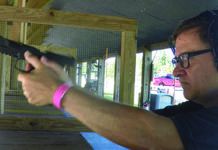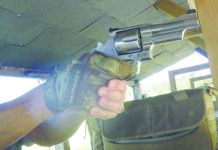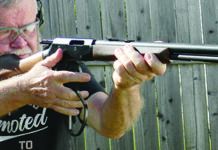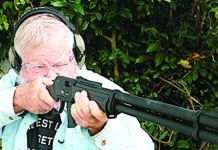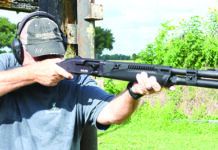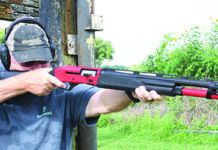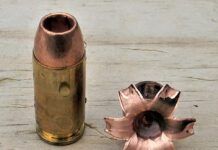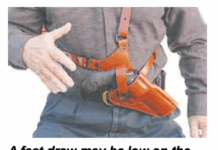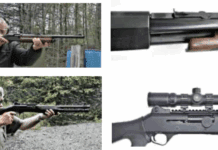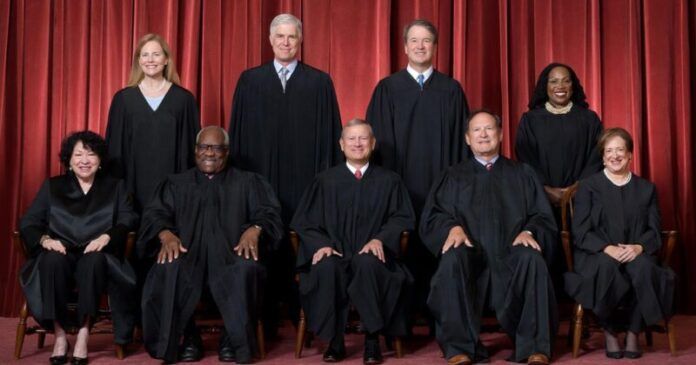A June 2, 2025, decision by the U.S. Supreme Court not to hear appeals in the Snope v. Brown and Ocean State Tactical v. Rhode Island cases can only mean the right to bear arms will remain “a second-class right,” as Justice Clarence Thomas wrote in his dissent disagreeing with the denial of review.
Those cases sought review of Maryland’s ban (Snope) on AR-15s, AR-10s, AK-47s, and AK-74s among other semi-auto mechanisms) and Rhode Island’s ban (Ocean State Tactical) on standard-sized magazines. To see the reasoning for the denials and the dissent, here are the statements by the court:
Statement
SUPREME COURT OF THE UNITED STATES
DAVID SNOPE, et al. v. ANTHONY G. BROWN, in his official capacity as ATTORNEY GENERAL OF MARYLAND, et al. on petition for writ of certiorari to the United States Court of Appeals for the Fourth Circuit.
No. 24–203. Decided June 2, 2025
The petition for a writ of certiorari is denied. Justice Alito and Justice Gorsuch would grant the petition for a writ of certiorari.
Statement of Justice Kavanaugh respecting the denial of certiorari.
In District of Columbia v. Heller, this Court ruled that the Second Amendment must be interpreted in light of constitutional text, history, and tradition. 554 U. S. 570, 576–628 (2008). The Court further determined that the Second Amendment protects those weapons that are in “common use” by law-abiding citizens. Id., at 624, 627. Because handguns are in common use by law-abiding citizens, the Court held that the District of Columbia’s ban on handguns violated the Second Amendment. Id., at 628–629. The Court’s later Second Amendment decisions in Bruen and Rahimi did not disturb the historically based “common use” test with respect to the possession of particular weapons. See New York State Rifle & Pistol Assn., Inc. v. Bruen, 597 U. S. 1, 47 (2022); see also United States v. Rahimi, 602 U. S. 680, 735–736 (2024) (Kavanaugh, J., concurring); post, at 1–6 (Thomas, J., dissenting from denial of certiorari).
This case primarily concerns Maryland’s ban on the AR–15, a semi-automatic rifle. Americans today possess an estimated 20 to 30 million AR–15s. And AR–15s are legal in 41 of the 50 States, meaning that the States such as Maryland that prohibit AR–15s are something of an outlier. See Staples v. United States, 511 U. S. 600, 612 (1994) (stating that AR–15s “traditionally have been widely accepted as lawful possessions”).
Given that millions of Americans own AR–15s and that a significant majority of the States allow possession of those rifles, petitioners have a strong argument that AR–15s are in “common use” by law-abiding citizens and therefore are protected by the Second Amendmentunder Heller. See Heller v. District of Columbia, 670 F. 3d 1244, 1286–1288 (CADC 2011) (Kavanaugh, J., dissenting). If so, then the Fourth Circuit would have erred by holding that Maryland’s ban on AR–15s complies with the Second Amendment.
Under this Court’s Second Amendment precedents, moreover, it can be analytically difficult to distinguish the AR–15s at issue here from the handguns at issue in Heller. AR–15s are semi-automatic, but so too are most handguns. (Semi-automatic handguns and rifles are distinct from automatic firearms such as the M–16 automatic rifle used by the military.) Law-abiding citizens use both AR–15s and handguns for a variety of lawful purposes, including self-defense in the home. For their part, criminals use both AR–15s and handguns, as well as a variety of other lawful weapons and products, in unlawful ways that threaten public safety. But handguns can be more easily carried and concealed than rifles, and handguns—not rifles—are used in the vast majority of murders and other violent crimes that individuals commit with guns in America.
In short, under this Court’s precedents, the Fourth Circuit’s decision is questionable. Although the Court today denies certiorari, a denial of certiorari does not mean that the Court agrees with a lower-court decision or that the issue is not worthy of review. The AR–15 issue was recently decided by the First Circuit and is currently being considered by several other Courts of Appeals. See Capen v. Campbell, 134 F. 4th 660 (CA1 2025); see also, e.g., National Assn. for Gun Rights v. Lamont, 685 F. Supp. 3d 63 (Conn. 2023), appeal pending, No. 23–1162 (CA2); Association of N. J. Rifle & Pistol Clubs, Inc. v. Platkin, 742 F. Supp. 3d 421 (NJ 2024), appeal pending, No. 24–2415 (CA3); Viramontes v. County of Cook, No. 1:21–cv–4595 (ND Ill., Mar. 1, 2024), appeal pending, No. 24–1437 (CA7); Miller v. Bonta, 699 F. Supp. 3d 956 (SD Cal. 2023), appeal pending, No. 23–2979 (CA9). Opinions from other Courts of Appeals should assist this Court’s ultimate decisionmaking on the AR–15 issue. Additional petitions for certiorari will likely be before this Court shortly and, in my view, this Court should and presumably will address the AR–15 issue soon, in the next Term or two.
Justice Thomas, dissenting from the denial of certiorari.
The State of Maryland prohibits ownership of AR–15s, the most popular civilian rifle in America. Md. Crim. Law Code Ann. §4–303(a)(2) (2025). This petition presents the question whether this ban is consistent with the Second Amendment. The Fourth Circuit held that it is, reasoning that AR–15s are not “arms” protected by the Second Amendment. Bianchi v. Brown, 111 F. 4th 438, 448 (2024) (en banc). I would grant certiorari to review this surprising conclusion.
I
The Second Amendment guarantees “the right of the people to keep and bear Arms.” When raising a Second Amendment challenge, an individual has the initial burden of showing that “the Second Amendment’s plain text covers [his] conduct.” New York State Rifle & Pistol Assn., Inc.v. Bruen, 597 U. S. 1, 17 (2022). Once a challenger makes that showing, “the Constitution presumptively protects [his] conduct,” and the burden shifts to the government to “demonstrate that [its] regulation is consistent with this Nation’s historical tradition of firearm regulation.” Ibid. If the government fails to make that showing, the restriction must be deemed unconstitutional. Ibid.
It is difficult to see how Maryland’s categorical prohibition on AR–15s passes muster under this framework. To start, AR–15s are clearly “Arms” under the Second Amendment’s plain text. In District of Columbia v. Heller, 554 U. S. 570 (2008), we held that the term “Arms” in this context covers all “ ‘[w]eapons of offence, or armour of defence.’ ” Id., at 581; see also ibid. (explaining that “Arms” include “ ‘any thing that a man wears for his defence, or takes into his hands, or useth in wrath to cast at or strike another’ ”). Thus, “the Second Amendment extends, prima facie, to all instruments that constitute bearable arms, even those that were not in existence at the time of the founding.” Id., at 582; accord, United States v. Rahimi, 602 U. S. 680, 691 (2024); Bruen, 597 U. S., at 28; Caetano v. Massachusetts, 577 U. S. 411 (2016) (per curiam). AR–15s fall squarely within this category.
Because AR–15s are “Arms,” the burden shifts to Maryland to show that banning AR–15s is “consistent with this Nation’s historical tradition of firearm regulation.” Bruen, 597 U. S., at 17. But, I am not aware of any “historical regulation” that could serve as “a proper analogue” to Maryland’s ban. Id., at 28–29.
Maryland invokes the “historical tradition of prohibiting the carrying of ‘dangerous and unusual weapons.’ ” Heller, 554 U. S., at 627 (citing 4 W. Blackstone, Commentaries on the Laws of England 148–149 (1769)); see Brief in Opposition 22–23. Under this tradition, however, “[a] weapon may not be banned unless it is both dangerous and unusual.” Caetano, 577 U. S., at 417 (Alito, J., concurring in judgment). “[W]eapons ‘in common use’ today for self-defense” and other lawful purposes remain fully protected. Bruen, 597 U. S., at 32 (quoting Heller, 554 U. S., at 627). And, AR–15s appear to fit neatly within that category of protected arms. Tens of millions of Americans own AR–15s, and the “overwhelming majority” of them “do so for lawful purposes, including self-defense and target shooting.” Friedman v. Highland Park, 577 U. S. 1039, 1042 (2015) (Thomas, J., joined by Scalia, J., dissenting from denial of certiorari); accord, ante, at 1–2 (Kavanaugh, J., statement respecting denial of certiorari); Harrel v. Raoul, 603 U. S. ___, ___ (2024) (Thomas, J., statement respecting denial of certiorari) (slip op., at 2). “[A] prohibition of an entire class of ‘arms’ that is overwhelmingly chosen by American society for th[ese] lawful purpose[s]” falls outside the government’s power. Heller, 554 U. S., at 628.
II
Despite the foregoing, the Fourth Circuit upheld Maryland’s ban on the ground that AR–15s are not “ ‘constitutionally protected arms’ ” under the plain text of the Second Amendment. 111 F. 4th, at 448. The court acknowledged that, “[a]t first blush, it may appear that [AR–15s] fit comfortably within the term ‘arms.’ ” Id., at 447. But, the court insisted, more is required. Because the Second Amendment “must be interpreted against its historical and legal backdrop,” the Fourth Circuit held that the challengers also had to show that “the right to possess” AR–15s falls within “the historical scope of the right to keep and bear arms.” Id., at 448. The challengers could not make this showing, in the court’s view, because the Second Amendment does not protect the right to own “ ‘dangerous and unusual weapons,’ ” including AR–15s. Id., at 450, 454–459.
This reasoning is dubious at least twice over. The Fourth Circuit placed too high a burden on the challengers to show that the Second Amendment presumptively protected their conduct. And, its determination that AR–15s are dangerous and unusual does not withstand scrutiny.
A
The Fourth Circuit erred by requiring the challengers to prove that the Second Amendmentprotects their right to own AR–15s—or, in the terms of our Second Amendment jurisprudence, that their conduct falls outside the historical exceptions to the right to keep and bear arms. A challenger need only show that “the plain text” of the Second Amendment covers his conduct. Bruen, 597 U. S., at 32. This burden is met if the law at issue “regulates” Americans’ “arms-bearing conduct.” Rahimi, 602 U. S., at 691. Once the challenger makes this initial showing, it is the government’s burden to show that a historic limit on the right to bear arms nevertheless justifies its regulation. The Fourth Circuit placed the burden of producing historical evidence on the wrong party.
Our precedents make plain the Fourth Circuit’s error. In Bruen, we had “little difficulty” determining that “the plain text of the Second Amendment” encompasses “carrying handguns publicly for self-defense.” 597 U. S., at 32. We considered the historical limits on the right to bear arms only to determine whether the State had met its burden of proving that its regulation was historically justified. See id., at 34–70. Likewise, in Rahimi, the Court found it self-evident that a law prohibiting individuals subject to domestic-violence restraining orders from possessing firearms “regulates arms-bearing conduct.” 602 U. S., at 691, 693. The Court again considered historical limits only after shifting the burden of proof to the Government. See id., at 693–702.
The Fourth Circuit based its contrary approach on an analogy to the Free Speech Clause of the First Amendment, but that analogy only underscores its error. The court reasoned that historical evidence is necessary to prevent an overbroad understanding of the Second Amendment, just as the Free Speech Clause excludes historically unprotected categories of speech such as “libel, incitement, true threats, fighting words, or falsely shouting fire in a crowded theater.” 111 F. 4th, at 447. As we explained in Bruen, however, “ ‘the Governmentbears the burden of proving the constitutionality’ ” of speech restrictions. 597 U. S., at 24 (emphasis added). “[T]hat burden includes showing whether the expressive conduct falls outside of the category of protected speech” by “point[ing] to historical evidence about the reach of the First Amendment’s protections.” Id., at 24–25 (emphasis deleted). Treating the Second Amendment “like . . . other constitutional provisions,” 111 F. 4th, at 448, we have similarly placed the burden on the government to show that a regulation of arms-bearing conduct falls outside the Second Amendment’s protection.
Under the plain text of the Second Amendment, the challengers’ only burden is to show that AR–15s are bearable “Arms”—i.e., “ ‘[w]eapons of offence.’ ” Heller, 554 U. S., at 581. By any measure, they are.
B
The Fourth Circuit separately erred in determining that AR–15s fall within the historic exception for dangerous and unusual weapons. “A weapon may not be banned” under this principle “unless it is both dangerous and unusual.” Caetano, 577 U. S., at 417 (opinion of Alito, J.). Weapons “ ‘in common use’ today for self-defense” are fully protected. Bruen, 597 U. S., at 32 (quoting Heller, 554 U. S., at 627). The Fourth Circuit nevertheless eschewed any inquiry into the commonality of AR–15s and the purposes for which they are used, which it dismissed as an “ill-conceived popularity test.” 111 F. 4th, at 460. Instead, the court performed its own independent investigation of AR–15s’ “utility for self-defense,” examining their “military origin,” “firepower,” and “muzzle velocity,” among other features. Id., at 454–459.
Our Constitution allows the American people—not the government—to decide which weapons are useful for self-defense. “A constitutional guarantee subject to future judges’ assessments of its usefulness is no constitutional guarantee at all.” Heller, 554 U. S., at 634. In line with that principle, and with the tradition of prohibiting only dangerous and unusualweapons, we have never relied on our own assessment of how useful an arm is for self-defense before deeming it protected. In Heller, we found handguns protected because that “class of ‘arms’ . . . is overwhelmingly chosen by American society for th[e] lawful purpose” of “self-defense.” Id., at 628. In Caetano, we recognized that stun guns were protected arms solely because they were not “ ‘unusual,’ ” without addressing the state court’s holding that stun guns were “ ‘dangerous per se at common law.’ ” 577 U. S., at 412; accord, id., at 417 (opinion of Alito, J.); Bruen, 597 U. S., at 28. And, in Bruen, we again found “handguns” protected solely because they are “ ‘in common use’ today for self-defense,” without inquiring whether they are in fact useful for that purpose. Id., at 32.
In response, the Fourth Circuit’s “[m]ost importan[t]” objection to a “common use inquiry” was that it would “lea[d] to absurd consequences,” such as a constitutional right to own a “bazooka,” “ricin pellet-firing umbrella gun,” or even a “W54 nuclear warhead” if such weapons become sufficiently “popular.” 111 F. 4th, at 460 (internal quotation marks omitted). This reasoning illustrates why the scope of the right to bear arms cannot turn on judicial speculation about the American people’s self-defense needs. Even if some nuclear warheads are small enough for an individual to carry, no reasonable person would think to use one to defend himself. Still less could nuclear warheads ever become a common means of self-defense. To fend off the fantastical threat of Americans lobbing nuclear warheads at one another, the Fourth Circuit has allowed the very real threat of the government depriving Americans of the rifle that they most favor for protecting themselves and their families. Looking to the standards set “by American society” rather than our judicial colleagues, Heller, 554 U. S., at 628, I cannot see how AR–15s fall outside the Second Amendment’s protection.1
III
I would not wait to decide whether the government can ban the most popular rifle in America. That question is of critical importance to tens of millions of law-abiding AR–15 owners throughout the country. We have avoided deciding it for a full decade. See Harrel, 603 U. S. ___; Friedman, 577 U. S. 1039. And, further percolation is of little value when lower courts in the jurisdictions that ban AR–15s appear bent on distorting this Court’s Second Amendmentprecedents. See Harrel, 603 U. S., at ___ (opinion of Thomas, J.) (slip op., at 2) (discussing the Seventh Circuit’s parallel conclusion that AR–15s do “not even fall within the scope of the Arms referred to by the Second Amendment”). I doubt we would sit idly by if lower courts were to so subvert our precedents involving any other constitutional right. Until we are vigilant in enforcing it, the right to bear arms will remain “a second-class right.” McDonald v. Chicago, 561 U. S. 742, 780 (2010) (plurality opinion).
The constitutional status of AR–15s is all the more urgent after this Court’s decision in Bondi v. VanDerStok, 604 U. S. ___ (2025). Recently amended regulations of the Bureau of Alcohol, Tobacco, Firearms and Explosives (ATF) provide that a “firearm” under the Gun Control Act includes objects that “may readily be completed, assembled, restored, or otherwise converted to” a working firearm. 27 CFR §478.11 (2023). In VanDerStok, this Court refused to hold that definition unlawful, reasoning that an “artifact noun”—that is, a “word for a thing created by humans”—may “refer to unfinished objects,” and thus that weapon-parts kits are as regulable as the firearms they might eventually become. 604 U. S., at ___ (slip op., at 10). But, “ ‘every single AR–15 can be converted to a machinegun using cheap, flimsy pieces of metal—including coat hangers.’ ” Id., at ___ (Thomas, J., dissenting) (slip op., at 13) (quoting VanDerStok v. Garland, 86 F. 4th 179, 208 (CA5 2023) (Oldham, J., concurring)). Thus, on the Court’s logic, it seems that ATF could at any time declare AR–15s to be machineguns prohibited by federal law. 604 U. S., at ___ (opinion of Thomas, J.) (slip op., at 13) (citing 26 U. S. C. §§5861, 5871). Until we resolve whether the Second Amendment forecloses that possibility, law-abiding AR–15 owners must rely on the goodwill of a federal agency to retain their means of self-defense. That is “no constitutional guarantee at all.” Heller, 554 U. S., at 634. I respectfully dissent.
Notes
1 The Fourth Circuit also purported to hold in the alternative that, assuming that AR–15s are protected arms, banning them is consistent with a national tradition of responding to the “threats posed by excessively harmful arms with responsive and proportional legislation.” 111 F. 4th, at 464. This holding, however, is not genuinely independent of its misguided common-use analysis. To support the existence of this tradition, the Fourth Circuit identified several 19th-century laws prohibiting certain easily concealable weapons like pistols, dirks, sword canes, and Bowie knives. See id., at 466–467. But, the court nowhere attempted to explain why these laws were not simply instances of States prohibiting dangerous and unusual weapons not in common use for self-defense. As the dissent noted, when these laws were challenged, 19th-century courts evaluated them based on “whether the regulated weapon was in common use for lawful purposes.” See id., at 510–513, 533–534 (opinion of Richardson, J.).




